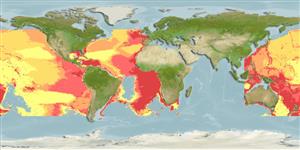Environment: milieu / climate zone / depth range / distribution range
Ecologia
marino batipelagico; non migratori; distribuzione batimetrica 300 - 1180 m (Ref. 44037). Deep-water; 55°N - 49°S, 113°E - 34°E
Eastern Atlantic: Morocco to Western Sahara; reported from Namibia (Ref. 27121). Western Atlantic: off Suriname and Nicaragua, and off southern Brazil. Indian Ocean: off Natal, South Africa and in the Great Australian Bight in the eastern side. Western Pacific: Australia (Ref. 7300). Eastern Pacific: British Columbia, Canada (Ref. 11980) and the Hawaiian Islands. South China Sea and East China Sea (Ref.74511).
Size / Peso / Age
Maturity: Lm ? range ? - ? cm
Max length : 25.0 cm SL maschio/sesso non determinato; (Ref. 4481)
Spine dorsali (totale): 0; Raggi dorsali molli (totale): 12-13; Spine anali 0; Raggi anali molli: 11 - 13. Sides of head and body dark red; silvery white below; fins pink (Ref. 6604).
Found over continental and island slopes. No evidence of vertical migrations (Ref. 6690). Benthopelagic (Ref. 58302).
Life cycle and mating behavior
Maturità | Riproduzione | Deposizione | Uova | Fecundity | Larve
Hulley, P.A., 1990. Neoscopelidae. p. 468-469. In J.C. Quero, J.C. Hureau, C. Karrer, A. Post and L. Saldanha (eds.) Check-list of the fishes of the eastern tropical Atlantic (CLOFETA). JNICT, Lisbon; SEI, Paris; and UNESCO, Paris. Vol. 1. (Ref. 4481)
IUCN Red List Status (Ref. 130435)
Threat to humans
Harmless
Human uses
Pesca: di nessun interesse
Informazioni ulteriori
BibliografiaAcquacolturaProfilo di acquacolturaVarietàGeneticaElectrophoresesEreditarietàMalattieElaborazioneNutrientsMass conversion
Strumenti
Special reports
Download XML
Fonti Internet
Estimates based on models
Preferred temperature (Ref.
123201): 5.9 - 13.2, mean 8.4 °C (based on 630 cells).
Phylogenetic diversity index (Ref.
82804): PD
50 = 0.6406 [Uniqueness, from 0.5 = low to 2.0 = high].
Bayesian length-weight: a=0.00513 (0.00201 - 0.01311), b=3.09 (2.87 - 3.31), in cm total length, based on LWR estimates for this (Sub)family-body shape (Ref.
93245).
Trophic level (Ref.
69278): 4.2 ±0.73 se; based on food items.
Resilienza (Ref.
120179): Medio, tempo minimo di raddoppiamento della popolazione 1.4 - 4.4 anni (Preliminary K or Fecundity.).
Fishing Vulnerability (Ref.
59153): Low vulnerability (21 of 100).
